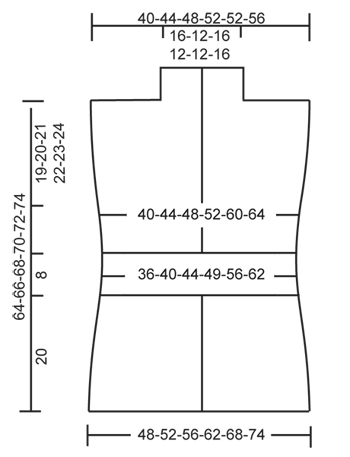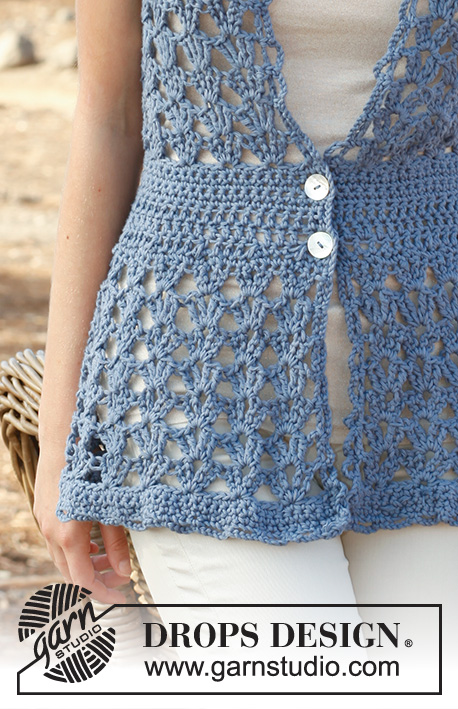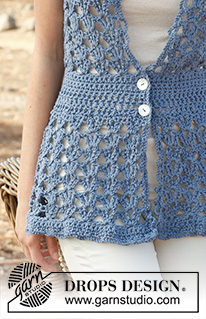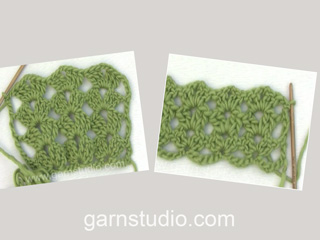Leona |
||||||||||||||||
 |
 |
|||||||||||||||
Crochet DROPS vest with fan pattern in ”Paris”. Size S-XXXL.
DROPS 145-4 |
||||||||||||||||
|
PATTERN: See diagrams A.1 and A.2 (diagrams A.3 and A.4 show dec for armhole in size XXL + XXXL). INCREASE TIP: Inc 1 dc by working 2 dc in same st. DECREASE TIP (dec 1 dc): Work 1 dc but wait with last pull through (= 2 sts on hook), then work next dc but on last pull through, pull thread through all sts on hook = 1 dc dec. ---------------------------------------------------------- VEST: Worked back and forth from mid front. Work 189-204-219-242-264-287 ch on hook size 6 mm with Paris, turn. ROW 1: 1 dc in 2nd ch from hook, * skip 1 ch, 1 dc in each of the next 2 ch *, repeat from *-* until 4-4-4-3-4-3 ch remain, skip next ch and finish with 1 dc in each of the last 3-3-3-2-3-2 ch = 126-136-146-161-176-191 dc on row, turn piece. ROW 2: 1 ch, then work 1 dc in every dc from previous row = 126-136-146-161-176-191 dc, turn piece. ROW 3: Work as 2nd row. ROW 4: Then work pattern according to diagram A.1, i.e. work 5 ch (= 1 dtr + 1 ch), * skip 4 dc, in next dc work 2 dtr + 2 ch + 2 dtr *, repeat from *-* until 5 dc remain, skip 4 dc and finish with 1 ch and 1 dtr in last dc = 24-26-28-31-34-37 dtr-groups, turn piece. ROW 5: 5 ch, in ch-loop in every dtr-group work 2 dtr + 2 ch + 2 dtr, finish row with 1 ch and 1 dtr in 4th ch on beg of previous row = 24-26-28-31-34-37 dtr-groups, turn piece. Repeat 5th row until piece measures approx. 16 cm. Work next row as follows: 4 ch (= 1 dtr), in ch-loop in the middle of every dtr-group work 2 dtr + 1 ch (instead of 2 ch) + 2 dtr, finish row with 1 dtr in 4th ch from beg of previous row = 24-26-28-31-34-37 dtr-groups, turn piece. Work 1 ch, 1 dc in same st, then work 1 dc in every dtr the entire row, finish with 1 dc in 4th ch from beg of previous row, turn piece = 98-106-114-126-138-150 dc. Continue to work as follows: ROW 1: Work pattern according to diagram A.2, i.e. work 1 ch, then work 1 dc in every dc the entire row AT THE SAME TIME dec 18-18-18-18-14-14 dc evenly – READ DECREASE TIP = 80-88-96-108-124-136 dc, turn piece. ROW 2: 3 ch (= 1 tr), then work 1 tr in every dc the entire row = 80-88-96-108-124-136 tr on row. ROW 3-5: Work as 2nd row = 80-88-96-108-124-136 tr. ROW 6: Work 1 dc in every tr AT THE SAME TIME adjust no of sts as follows: Size S + M + L + XL + XXL: Inc 5-9-5-5-5 dc evenly – READ INCREASE TIP. Size XXXL: Dec 3 sts evenly – READ DECREASE TIP = 85-97-101-113-129-133 dc, turn piece. ROW 7: 1 ch, 1 dc in same st, then work 1 dc in every dc from previous row = 85-97-101-113-129-133 dc, turn piece. ROW 8: 5 ch, * skip 3 dc, in next dc work 2 dtr + 2 ch + 2 dtr *, repeat from *-* until 4 dc remain on row, skip 3 dc and finish with 1 ch and 1 dtr in last dc on row = 20-23-24-27-31-32 dtr-groups on row, turn piece. ROW 9: Then work pattern according to diagram A.1 again, i.e. work 5 ch, in ch-loop in the middle of every dtr-group work 2 dtr + 2 ch + 2 dtr, finish row with 1 ch and 1 dtr in 4th ch on beg of previous row = 20-23-24-27-31-32 dtr-group. Repeat 9th row upwards. AT THE SAME TIME when piece measures 45-46-47-48-49-50 cm, divide for markers as follows: Insert 1 marker after 5-6-6-7-8-8 dtr-groups in from each side (= 10-11-12-13-15-16 dtr-groups between markers on back piece). Finish each part separately. BACK PIECE: = 10-11-12-13-15-16 dtr-groups. Continue back and forth with dtr-groups as shown in A.1. AT THE SAME TIME on 1st row dec for armholes in each side in size XXL + XXXL as follows: Dec 1 dtr-group on beg of row as shown in A.3, work as before until 1 dtr-group remains on row, finish row as shown in A.4 (do not dec in the other sizes) = 10-11-12-13-13-14 dtr-groups remain on row. Continue pattern back and forth until 1 row remains before piece measures 64-66-68-70-72-74 cm. Now work 1 row with dtr-groups only over the outermost 3-4-4-5-5-5 dtr-groups in the one side of piece: 5 ch, * in ch-loop in the middle of next dtr-group work 2 dtr + 2 ch + 2 dtr *, repeat from *-* 3-4-4-5-5-5 times in total, finish with 1 dtr in last dtr in same dtr-group, turn piece. Now work 1 row dc as follows: 1 ch, 1 dc in same st, * 1 dc in each of the first 2 dtr, 1 dc in ch-loop in the middle of dtr-group, 1 dc in each of the next 2 dtr *, repeat from *-* 3-4-4-5-5-5 times in total, finish with 1 dc in last ch and 1 dc in 4th ch from beg of previous row = 18-23-23-28-28-28 dc on row. Cut and fasten the thread. Repeat on the other shoulder (i.e. do not work over the middle 4-3-4-3-3-4 dtr-groups = neck.) RIGHT FRONT PIECE: = 5-6-6-7-8-8 dtr-groups. Continue back and forth with dtr-groups as on back piece. AT THE SAME TIME on 1st row dec for armhole in the side in size XXL + XXXL as shown in A.4 (do not dec in the other sizes) = 5-6-6-7-7-7 dtr-groups. Continue pattern back and forth until piece measures approx. 64-66-68-70-72-74 cm – adjust so that same no of rows with dtr-groups has been worked as on back piece. Now work 1 row dc as on back piece only over the outermost 3-4-4-5-5-5 dtr-groups on shoulder (i.e. do not work over the 2 dtr-groups towards the neck = collar) = 18-23-23-28-28-28 dc. Cut and fasten the thread. Insert 1 marker on the shoulder. Now work dtr-groups back and forth over collar as follows: 5 ch, in ch-loop in first dtr-group work 2 dtr + 2 ch + 2 dtr, in ch-loop in next dtr-group work 2 dtr + 2 ch + 2 dtr, work 1 ch and finish with 1 dtr in last dtr in same dtr-group. Continue back and forth like this until collar measures approx. 10-8-10-8-8-10 cm from marker on shoulder. Then work 1 row dc as follows: 1 ch, 1 dc in same st, 1 dc in next ch, 1 dc in each of the first 2 dtr, 1 dc in ch-loop in the middle of dtr-group, 1 dc in each of the next 2 dtr *, repeat from *-* 2 times in total, finish with 1 dc in last ch and 1 dc in 4th ch from beg of previous row = 14 dc, cut the thread. LEFT FRONT PIECE: Work as right front piece but reversed. When dec for armhole in size XXL + XXXL, dec 1 dtr-group as shown in A.3. ASSEMBLY: Sew shoulder seams edge to edge to avoid a chunky seam. Sew collar tog mid back (sew edge to edge) and sew it on to neck line at the back of neck. Sew on buttons on right front piece – see picture. Button through the crochet edge explained below. CROCHET EDGE: Work a finishing edge around the entire opening on vest and around both armholes as follows: 1 dc in first st, * 5 ch, skip approx. 2½ cm, 1 dc in next st/loop *, repeat from *-* the entire round and finish with 5 ch and 1 sl st in dc from beg of round. |
||||||||||||||||
Diagram explanations |
||||||||||||||||
|
||||||||||||||||

|
||||||||||||||||

|
||||||||||||||||
|
Have you made this or any other of our designs? Tag your pictures in social media with #dropsdesign so we can see them! Do you need help with this pattern?You'll find tutorial videos, a Comments/Questions area and more by visiting the pattern on garnstudio.com. © 1982-2024 DROPS Design A/S. We reserve all rights. This document, including all its sub-sections, has copyrights. Read more about what you can do with our patterns at the bottom of each pattern on our site. |
||||||||||||||||














































Comments / Questions (189)
Hi I need help with front right piece. I have crochet till 68cm and SC row on outermost 4tr. So this number of rows will be same as back piece? I understood that balance 2tr will be used for collar. Do i need to crochet this 2tr until measures 10cm? And will be stitched to back of neckline? If we fold the collar then won't the fan pattern will be opposite? Thank you for your help.
15.09.2020 - 15:36DROPS Design answered:
Dear Aishwarya, on right front piece, you work over the 4 tr-groups (not 4 tr) = 23 sc for the shoulder. Now you work over collar piece = 5 ch, 2 tr +2 ch + 2 tr in next ch-space, 2 tr + 2 ch + 2 tr in next ch sp = 2 tr-groups for 10 cm - you will then work the same collar piece (= towards mid front) on left front piece then sew the last row together and sew the collar along neckline on back piece. Happy crocheting!
15.09.2020 - 15:47Hii I didn't understood the back piece construction after placing markers. Can you please explain in detail. Like how only crochet 4 tr from each side etc. Also can I have image to understand better? Help is much appreciated since I am in the middle of vest. Thank you so much
09.09.2020 - 18:01DROPS Design answered:
Dear Aishwarya, when 1 row remains before piece measures 66-68 cm (see size), you will crochet the shoulders separately leaving the middle 3-4 tr-groups unworked for neck, ie work: ch5, * in ch-space in the middle of next tr-group work 2 tr+ch2+2 tr *, repeat from *-* 4 times in total, finish with tr in last tr in same tr-group, turn piece, work ch1, 1sc in same st, * 1sc in each of the first 2tr, 1sc in ch-space in the middle of tr-group, 1sc in each of the next 2tr *, repeat from *-* 4 times in total, finish with 1sc in last ch and 1sc in 4th ch from beg of previous row = 23sc. Work now 2nd shoulder same way over the 4 tr-groups on the other side of back piece. Happy crocheting!
10.09.2020 - 09:24I have a sizing query. I am a 44” bust. Do the diagram bust measurements relate to the entire circumference (ie includes the gap of the V-neck) or just the actual fabric (V-neck round to other side of V-neck, excluding the gap at the front). I’m trying to work out which size to make. Thank you.
25.08.2020 - 03:36DROPS Design answered:
Hi Victoria, The measurements in the diagram are from one side to the other, so need to be doubled for your bust size. Happy crocheting!
25.08.2020 - 08:38I'm trying to follow the pattern but I'm confused about the treble, do I put yarn round hook twice or once?
26.07.2020 - 03:11DROPS Design answered:
Dear Elouise, if you are following UK-English pattern, a treble is worked with 1 yarn over (see video) but if you are following the pattern in US-English, a treble should be worked with 2 yarn overs (see video). Make sure to select the appropriate language! Happy crocheting!
29.07.2020 - 10:49Hallo und einem schönen guten Abend. Ich hab da mal eine frage, wieviel Wolle Drops Paris brauche ich bei XL?? Liebe Grüße Tatjana 🙃
31.05.2019 - 21:34DROPS Design answered:
Liebe Tatjana, im Kopfteil finden Sie die Garnmenge für jede Größe - mehr über die Garnmenge hier lesen. Viel Spaß beim häkeln!
03.06.2019 - 08:24I don't understand what you mean by until 4-4-4-3-4-3 then 1 sc until 3-3-3-2-3-2 ch remain.
25.10.2018 - 19:26DROPS Design answered:
Hi Barbara, The numbers correspond to the sizes S - M - L - XL - XXL - XXXL, so if (for example) you are working Size S you use the first number in all the series. Happy crocheting!
26.10.2018 - 08:15I love this pattern. But I don't understand it.. after row 5 Im lost. Can you help me understand it.
09.05.2018 - 02:38DROPS Design answered:
Dear Debbie, after you have worked row 5, repeat this row until piece measures approx. 16 cm / 6 1/4'' then work next row as explained and continue following A.2 as described. For any individual assistance reading diagrams and/or pattern please contact the store where you bought your yarn (even per mail, telephone or via social medias). Happy crocheting!
09.05.2018 - 08:53The measurements for a small states 31 1/2 for the bust but the diagram shows 36 at the waist. Am i reading that correctly? If I want a smaller waist, can I start with 174 chain and adjust accordingly?
21.04.2018 - 04:49DROPS Design answered:
Dear Mrs Liefeld, in the smallest size piece measures 40 cm (see chart) ie 80 cm around = 31½", at the waist, it will measure 36 cm as in chart, ie 72 cm around = 28.35" - read more about measurements and convert into inches here. Happy crocheting!
23.04.2018 - 08:30Chantelle wrote:
Hi there I am up to contraction of the vest but don't understand how to do the collar. Is there a photo of the back of the vest or a diagram that I can follow ?
13.09.2017 - 06:20DROPS Design answered:
Dear Chantelle, you are working here an simple shawl collar, working on the first sts on front piece only until they are long enough to reach the middle of neck on back piece; this video shows the technique on a knitted piece, just work as explained in pattern to get the same. Happy crocheting!
13.09.2017 - 09:03Sziasztok! A horgoláspróba nekem 7es tűvel lett, jó, de "élesben" elég volt a javasolt 6os tű, a méret úgy volt jó.
24.08.2017 - 11:43DROPS Design answered:
Kedves Emese! Köszönjük a megjegyzést. Mindenki kicsit másképp köt / horgol, ezért a kötés/horgolás-próba is eltérhet. Pontosan ez az oka, hogy mindig azt javasoljuk, először készítsen próbadarabot, és annak megfelelően változtassa a használt tű méretét. Örömteli kézimunkázást!
30.08.2017 - 08:10